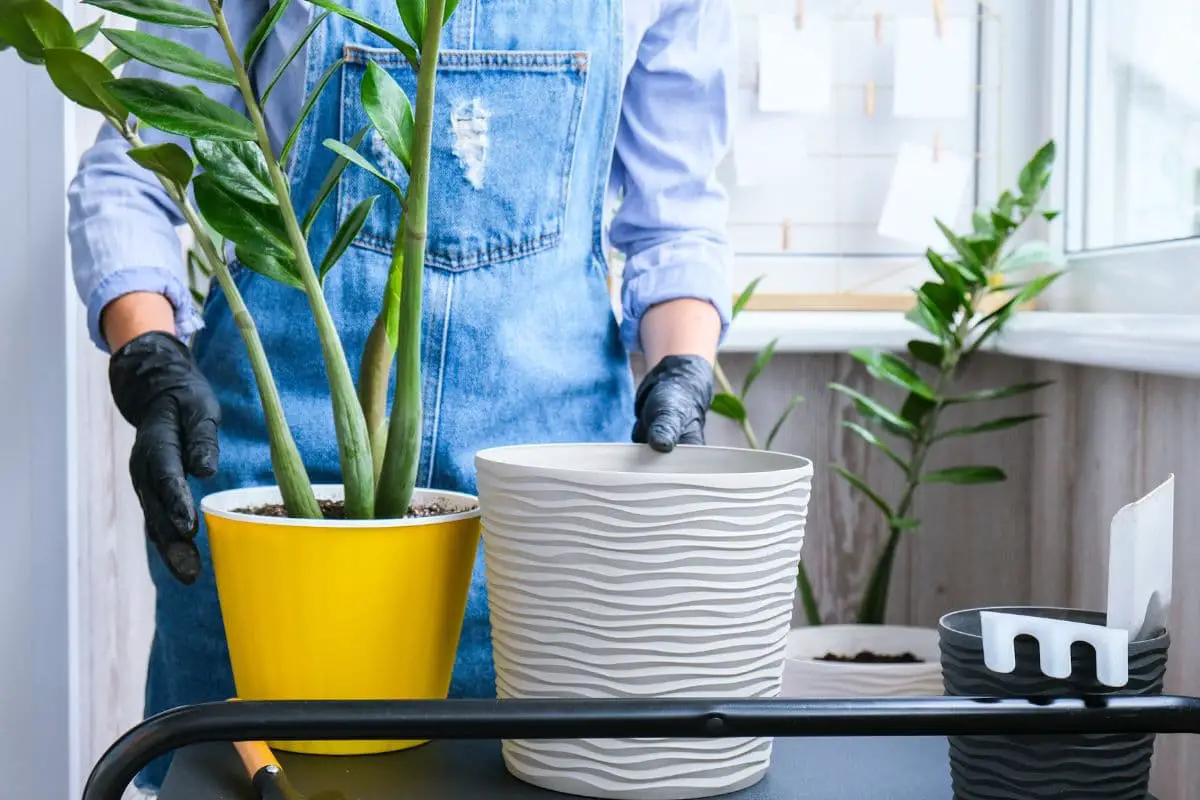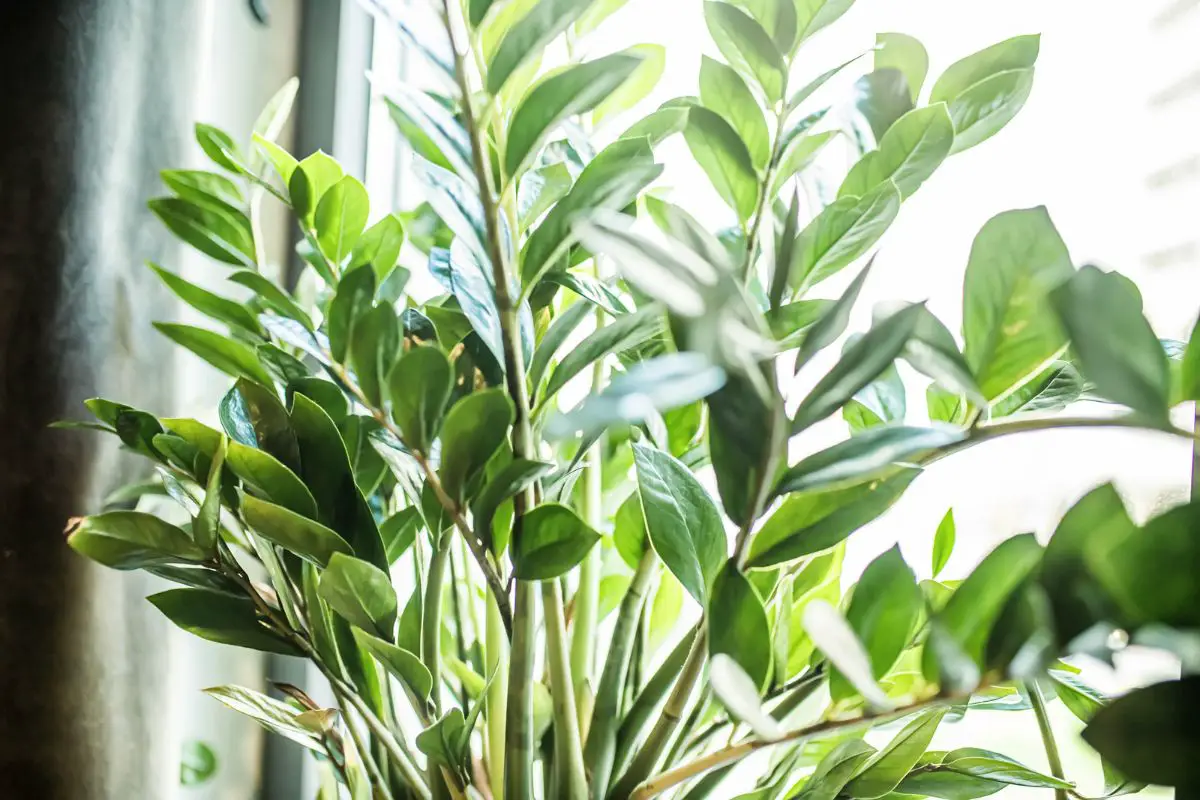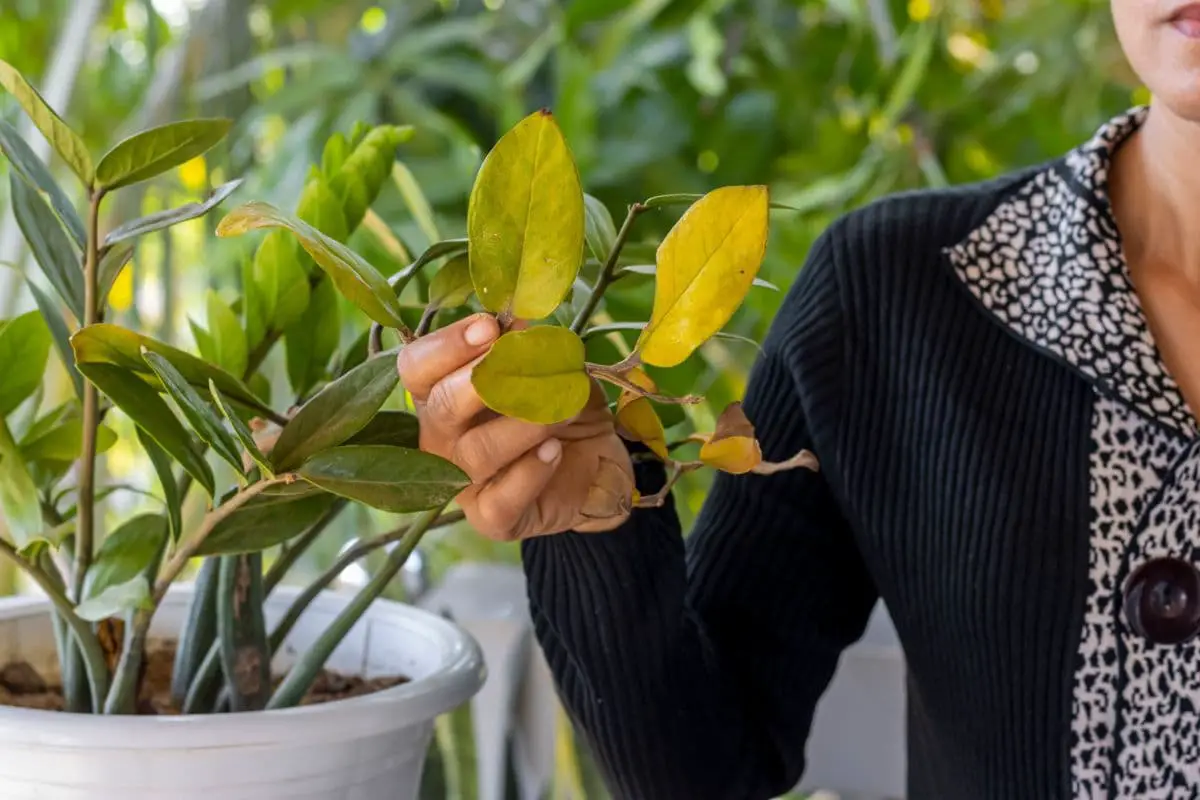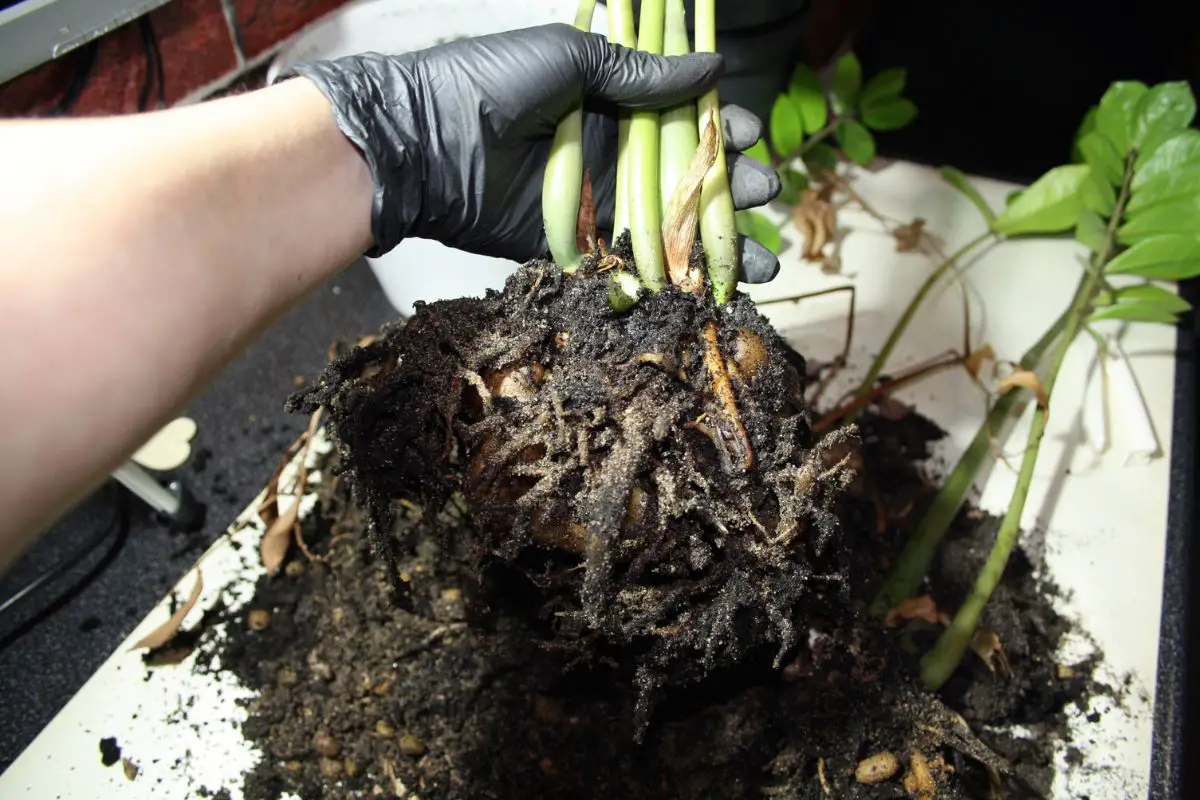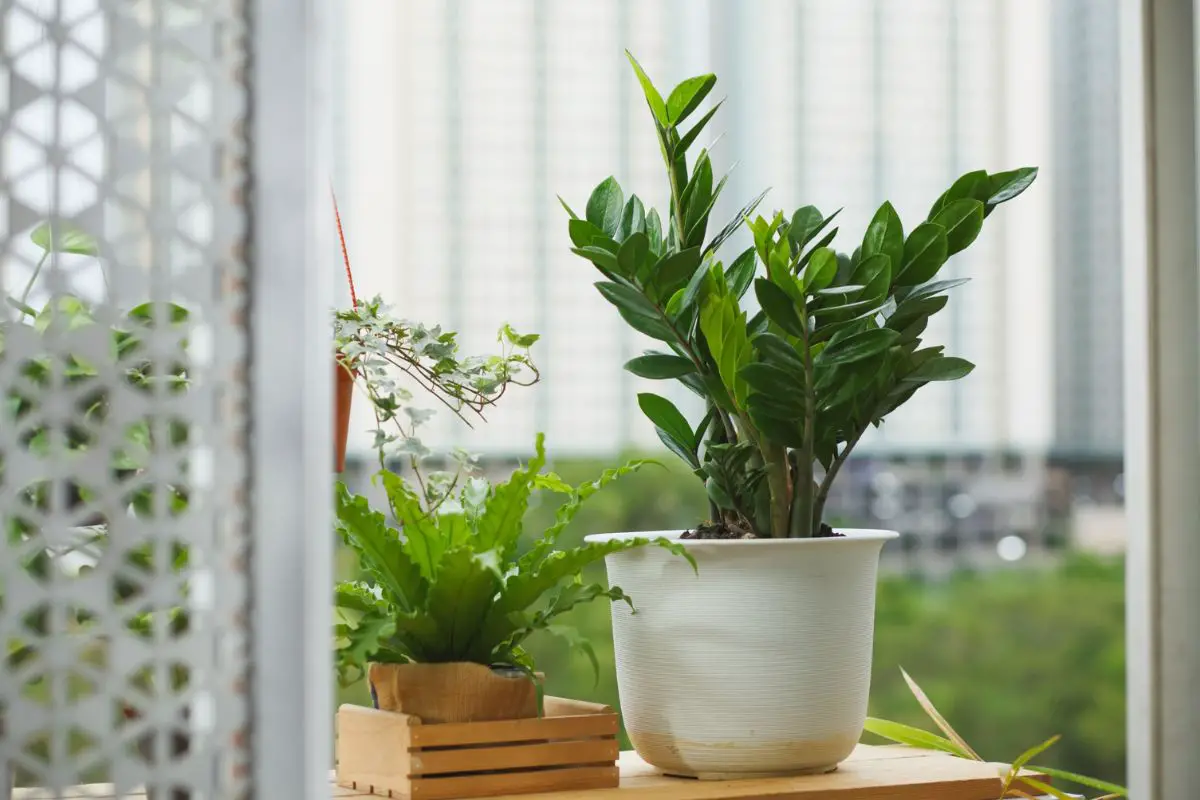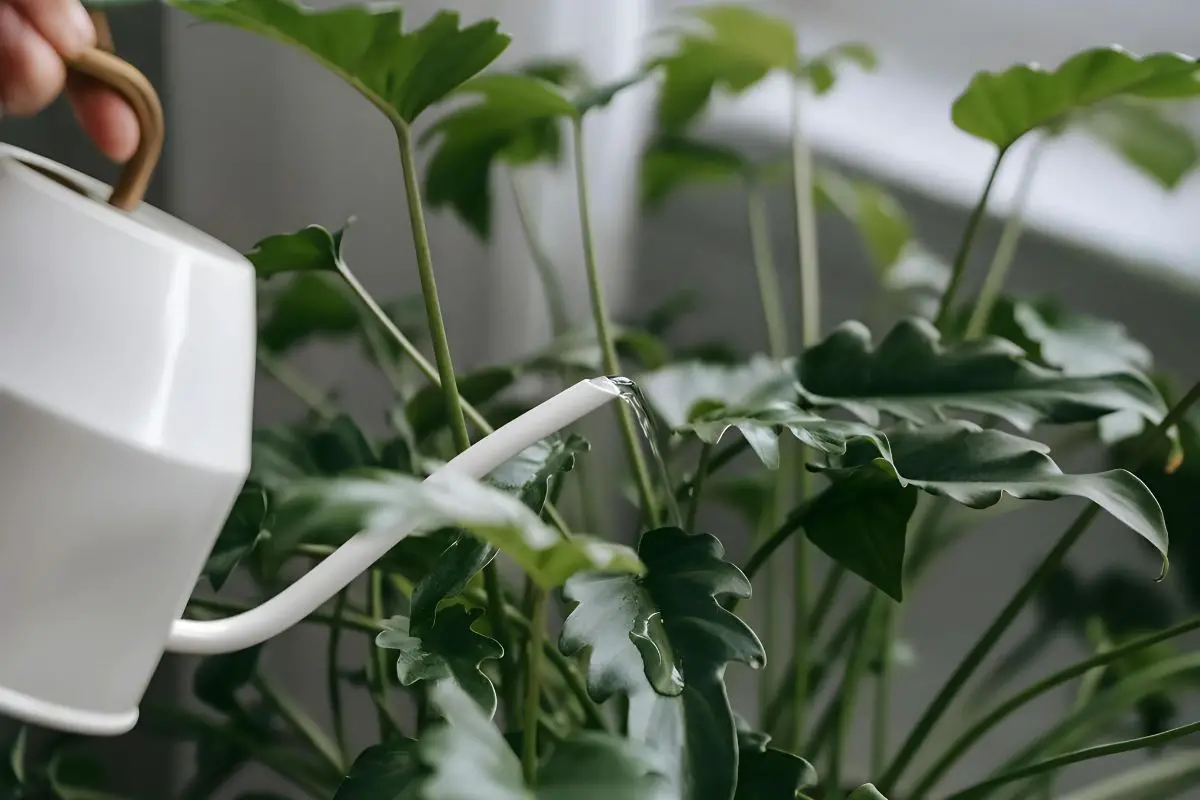ZZ plants have a remarkable drought tolerance, making them popular low-maintenance houseplants. Their fleshy roots, rhizomes, and stems store moisture, allowing them to go about a month without water.
You must water ZZ plants as soon as the top half of the potting mix is dry. This can be every 2-3 weeks during mild seasons like spring and early fall. Reduce the interval during summer or if your plant is in medium-light conditions. Conversely, increase the interval during the cold season.
Getting the watering routine right is crucial for the health and longevity of ZZ plants. They’re drought-tolerant but are sensitive to overwatering. In the rest of the article, I’ll explore everything you need to know about their watering needs.

ZZ Plant Watering Needs: An Overview
ZZ plants are native to East and South Africa where there are wet and dry seasons. During the wet season, they receive sufficient rain every 3 days or so. Conversely, there are sporadic rains during the dry season.
They grow in sandy soils where rainwater is drained quickly, encouraging them to absorb and store moisture in their fleshy roots, potato-like rhizomes or bulbs, and succulent stems. These structures allow the plant to survive infrequent watering.
ZZ plants preserve moisture through the waxy coating on their leaves. The dappled sun they receive all day also prevents rapid moisture loss.
It helps to replicate these conditions when growing ZZ plants indoors to keep them at optimum health and retain their healthy, vibrant leaves longer.
Here are some things to remember when creating the perfect environment for ZZ plants in your home:
Sunlight
Give them bright, indirect light for 8 hours a day. Choose a spot next to an unobstructed northern window or 4-8 feet (1.2-2.4 m) from an eastern or a curtained western or southern window.
Soil
Prepare a loose soil mix rich in organic matter. I prefer using equal parts compost and perlite for ZZ plants for a gentle dose of slow-release nutrients, organic matter, and good drainage.
Pot/Container
Choose a pot that’s 2 inches (5 cm) wider and deeper than the rootball. Leave another 2 inches (5 cm) of space between the topmost bulb and the rim of the pot to keep the bulbs buried about an inch (2.5 cm) below the soil surface. The roots will eventually grow and push the new bulbs upward.
Temperature & Humidity
Keep your plant at moderate temperature and humidity levels. Optimum values are 65-85 °F (18-29 °C) and 40-50% humidity.
Maintaining these conditions for your ZZ plant will allow it to maximize its natural water storage and utilization mechanisms. Consequently, you will have a lenient plant care and watering routine.
Timing and Frequency
In my experience, ZZ plants do great when watered once every 2-3 weeks as long as they stay within the recommended environmental conditions.
Additional considerations must be given based on the factors below.
Soil Dryness
The primary factor I consider when planning my houseplant’s watering schedule is how quickly the soil dries out.
For ZZ plants, my general rule is to water as soon as the top half of the potting mix is dry. They don’t mind even when the soil dries out completely. However, I avoid letting the soil become bone-dry too often to prevent it from becoming hydrophobic over time.
You can use your fingers or a wooden chopstick to check the soil moisture. Just be careful not to puncture or wound the bulbs in the process to prevent entry points for rot-causing pathogens in the soil.
Here are the methods:
- Finger test: This is recommended if the pot is shallow and the plant is small. Poke your finger two knuckles (2 inches or 5 cm) deep to check if the soil is completely dry.
- Chopstick test: This is best for mature plants in deeper pots. Choose 3-4 spots around the soil closer to the edges to avoid puncturing the bulbs. Twist the chopstick between your thumb and index finger as you wiggle it into the soil.
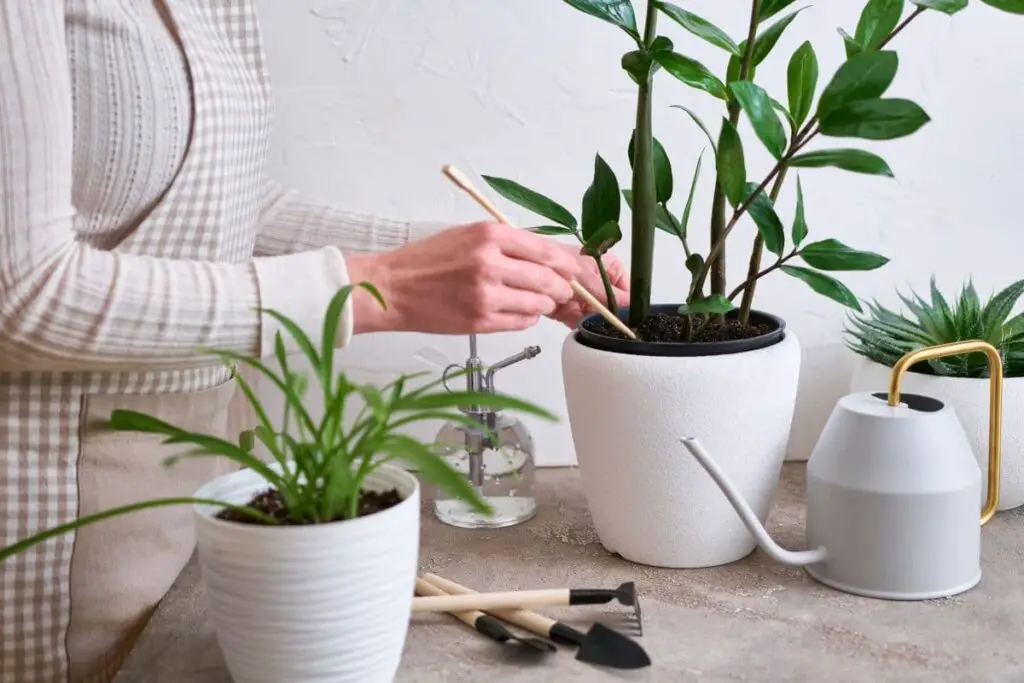
Seasonal Variations
In the wild, ZZ plants put out noticeable growth of up to 6 inches (15 cm) during the wet season. You can replicate this with regular watering in spring and summer.
You may need to increase the frequency to once every 10-14 days in the summer under the following conditions:
- The light intensity increases around your ZZ plant.
- The average indoor temperature is 5-10 °F or 3-6 °C higher and the humidity is 10-20% lower than usual.
- You bring your plant outdoors for the summer.
On the other hand, give your plant some rest during the cold season by replicating the dry season in their native environment. As temperatures slowly drop in late summer and early fall, gradually increase the interval by one week.
You should be able to water your ZZ plant only once every 4-6 weeks by mid-fall until late winter. This lower watering frequency (combined with drier air conditions and lower light levels) will prompt your plant to grow more slowly with only 1-2 inches (2.5-5 cm) of growth throughout the cold season.
This will give your ZZ plant renewed energy for growth spurts in spring and even flowering in late summer.
Pot Type and Size Considerations
The pot type and size can also influence watering frequency.
Unglazed clay pots have porous walls that wick away excess moisture and improve air circulation within the root zone.
Plastic or ceramic pots, on the other hand, have non-breathable walls. They rely on adequate drainage holes and loose substrates to release excess moisture and prevent waterlogging.
Pro tip: Water ZZ plants in non-breathable pots less frequently. You can wait until the upper ⅔ of the soil is dry before watering if you have plastic or ceramic pots. Check the soil moisture with the finger or chopstick test to determine if it’s time to water your plant.
Avoid using oversized pots for ZZ plants. They grow pretty slowly, so it can take 2-3 years to fill the soil space with roots and new bulbs. Too much soil will hold unwanted excess moisture and increase the risk of root rot.
Remember the recommended pot size and soil mix recipe above to avoid watering problems with your ZZ plant.
Watering Tips and Methods
Here are general tips to water your ZZ plants:
- You can use tap, filtered, or rainwater.
- Use tepid water around 68 °F (20 °C) to prevent heat or cold shock to the roots.
- Avoid using self-watering pots because they keep the substrate consistently moist, which can cause root and bulb rot in ZZ plants.
You can water your ZZ plant from the top or the bottom.
Here are the steps:
Top Watering
This method is efficient time-wise. It’s also practical if you have large pots you can’t carry into the tub or sink for bottom watering.
- Water the soil gradually using cups, counting how many cups it takes until the excess leaks out of the drainage holes. It typically takes ½ gallon (1.9 liters or 8-9 cups) of water to fully saturate the soil in a 1-gallon (3.8 l) pot.
- Avoid wetting the leaves or letting excess water pool at the base of the stems to prevent leaf spots and crown rot.
- Let the pot sit on a drip tray until the water stops dripping below the pot.
- An hour after placing the pot on its saucer, check the saucer for pooling water and throw it out to prevent reabsorption into the soil.
Here are some additional tips when top watering:
- If you habitually let the soil dry out completely between watering, use the full amount of water based on the number of cups you recorded above.
- If you water the plant as soon as the upper half of the soil mix is dry, use half the amount (i.e., 4-5 cups of water for every 1-gallon (3.8 l) pot).
- Use a watering can with a long, narrow spout. Carefully move the spout around the base of the plant to avoid pouring water over one spot and displacing the soil.
- Occasionally replenish the soil mix over the surface when you notice some bulbs poking out. Keep them ½-1 inch (1.3-2.5 cm) below the soil surface while leaving about half an inch (1.3 cm) of space between the soil surface and the pot’s rim to prevent spilling. If it’s not possible, it may be time to repot your plant.
- Put a large pot (over 2 gallons) on a stand that will allow you to place a drip tray or small container below the drainage holes to catch the excess water.
Bottom Watering
Use bottom watering every other time you water your plant if you let the soil dry out completely between watering. This will help prevent the soil from becoming hydrophobic.
- Fill a tub or bucket with enough water to reach the bottom third or half of the pot.
- Place the pot in the tub and let the soil absorb the water through the drainage holes.
- Check back after 10 minutes to see if the surface is moist. If it isn’t, check back again at 5-minute intervals.
- Once the surface feels moist, remove the pot from the water and let it sit on a drip tray.
Common Mistakes (& Fixes)
ZZ plants are resilient houseplants and require minimal care. Most problems that affect their health and appearance come from poor watering practices.
Overwatering
Poor soil drainage, oversized pots, and frequent watering can lead to overwatering issues.
The roots and rhizomes are sensitive to excess moisture because they’re used to drier soil conditions in their native habitat. If the soil is constantly wet, the roots can’t breathe, and pathogens can reproduce rapidly and infect the roots, causing rot.
Here are the symptoms of overwatered ZZ plants:
- Wet, soggy soil
- Brown, water-soaked lesions with yellow margins
- Uniform yellowing of nutrient-deprived bottom/older leaves
- A foul odor coming from the roots
- Black, mushy roots, bulbs, and stems
Depending on the cause or underlying issue that led to overwatering, you can fix the problem in the following ways:
- Reduce watering frequency and water only when the soil is adequately dry (top half).
- Repot the ZZ plant in soil and pot with better drainage.
- If less than half the roots and bulbs are damaged, treat the rot by pruning the damaged sections and repotting the plant in fresh soil and a sterile pot.
- Propagate the remaining healthy leaves if the entire root system and bulbs are rotten.
Underwatering
Although drought-tolerant, ZZ plants will show distress when underwatered, especially during the warm growing season.
They typically can go up to 2 months without water before showing signs of drought stress, including the following:
- Drooping or wilting leaves
- Yellow leaf tips that eventually turn brown and crisp
- Brown stems
- Hydrophobic soil with crusty surface and cracks
The fixes for underwatered ZZ plants can vary depending on the severity:
- Mildly underwatered ZZ plants with drooping leaves will bounce back a few days after proper watering. Yellowing leaves without browning can also recover their green color. Pinch leaves with brown, crisp tips because they won’t recover and can negatively affect the plant’s appearance.
- Severely underwatered ZZ plants with hydrophobic soil may require dunking in water with a wetting agent. If you don’t have a wetting agent, you can repot the plant in fresh soil mix.
Neglecting Environmental Changes
It’s important to adjust your watering routine based on the changes in environmental conditions around your ZZ plant.
Here are some changes to look out for and potential fixes:
- Rising temperatures and light intensity in the summer: Move the plant a few feet (+ 0.6 m) away from a bright window or increase the watering frequency.
- Lower temperatures and light intensity in winter: Move the plant closer to the window or use artificial lights to give your plant 10-12 hours of low-light intensity. In addition, reduce watering frequency accordingly.
Changes in humidity levels can also mildly affect how quickly the soil dries out.
You can address this issue independently by maintaining optimal humidity levels through the following steps:
- Reduce humidity using a dehumidifier or by improving air circulation using fans.
- Increase humidity using a humidifier, placing your plant over a pebbled tray with water, or grouping houseplants with similar lighting needs together.
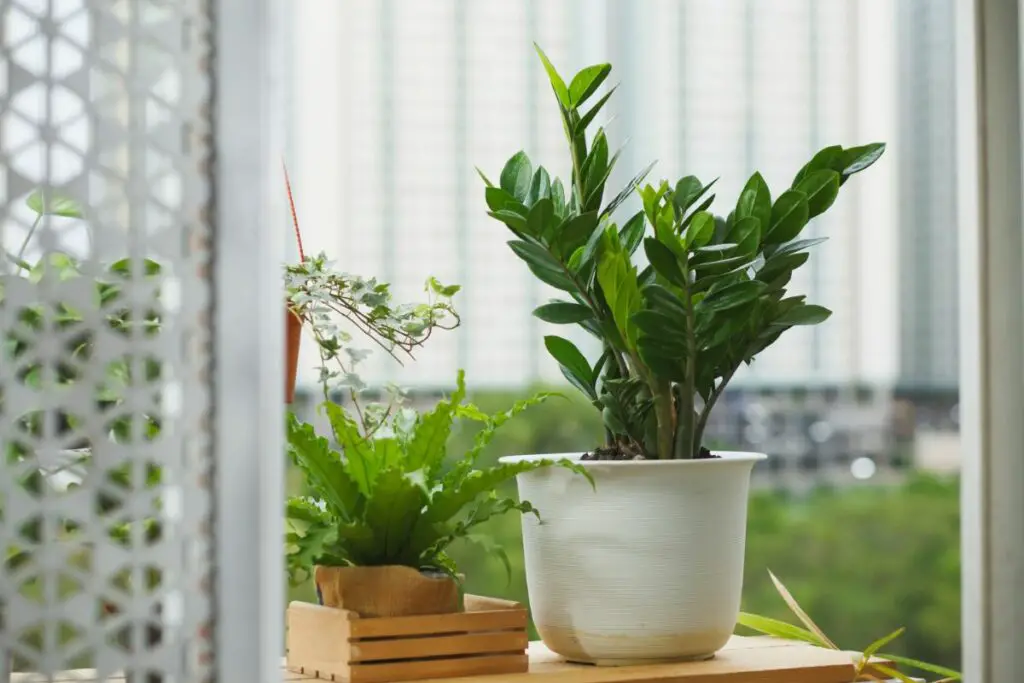
Advanced Tips
Since environmental conditions can vary across homes, you can refer to your ZZ plant’s response to watering. Monitor your plant for signs of over- or underwatering and adjust the watering frequency as necessary.
ZZ plants typically show signs of overwatering within 2 weeks, especially if there’s root rot. On the other hand, it can take up to 2 months of drought for your plant to start showing signs of dehydration.
If you’re a beginner gardener and can’t tell yet whether the plant is over- or underwatered, I recommend using a moisture meter. It has a metal probe you can insert into the soil and a moisture level calibration on top ranging from 1-10.
Be careful not to puncture the roots and bulbs with the probe and check multiple spots for accuracy. You can water the ZZ plant when the reading average is 2-3.
Final Thoughts
ZZ plants are generally fuss-free and remain vibrant with minimal care. They tolerate occasional underwatering but are sensitive to overwatering, which can severely affect their appearance or even kill them due to root rot.
You can follow the recommended seasonal watering frequencies in this article to help you get started with ZZ plant care and adjust accordingly based on your plant’s response.
Please leave a comment with questions or share tips about your personal ZZ plant care routine to help fellow plant enthusiasts have a thriving indoor garden.

